Big Bend National Park, located within the bend of the Rio Grande in southwestern Texas, encompasses the largest protected area representative of the Chihuahuan Desert. More than 450 species of birds have been recorded at the park, including some unique Mexican species that only range into the U.S. along the border.
Introduction
Hundreds of species of birds occur in the American Southwest, which makes for some of the best birdwatching opportunities. Birds are a highly visible component of many ecosystems. Because they can respond quickly to changes in resource conditions, birds are considered good indicators of ecosystem health. Monitoring changes in bird population and community parameters can be an important component of any comprehensive, long-term monitoring program. Monitoring birds is especially critical given population declines for some species in recent decades, especially neotropical migratory birds. The Chihuahuan Desert Network (CHDN), of which Big Bend National Park (NP) is a part, will begin annual landbird monitoring at the park in 2010. However, many avian monitoring and research studies have been conducted in the past, with a number continuing today. This overview discusses the birds of Big Bend NP and a sampling of the surveys and studies that have been conducted to date; these include surveys/studies for wintering birds, migratory birds, and breeding birds, as well as those focused on particular species of interest.
Big Bend NP and its Specialty Birds
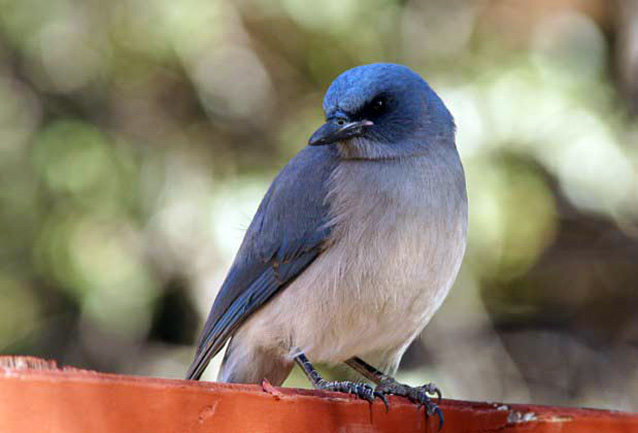
Photo © Robert Shantz
Big Bend NP, located within the bend of the Rio Grande in southwestern Texas, is greater than 800,000 acres in size. The park encompasses the largest protected area representative of the Chihuahuan Desert and is classified as a U.S. Biosphere Reserve. The park includes 533,900 acres of recommended Wilderness and administers the 190-mile (305-kilometer) Rio Grande Wild and Scenic River. Elevations in the park range from about 1,798 feet (548 meters) to about 7,800 feet (2,377 meters). Eight basic land-cover types occur at the park; these are, in order of predominance, desert shrubland, igneous grassland, limestone grassland, riparian vegetation, montane woodland, bare ground, developed areas, and surface water (Gutzwiller and Barrow 2008).
More than 450 species of birds have been recorded at Big Bend NP. The park contains species common to other areas, as well as Mexican species that range into the U.S. only along the border (especially into the Chisos Mountains or within the border country of Texas to Arizona). Some of these unique birds include the Mexican duck (Anas platyrhynchos diazi), the lucifer hummingbird (Calothorax lucifer), the Mexican jay (Aphelocoma ultramarina), the black-capped (Vireo atricapillus) and gray vireos (Vireo vicinior), the colima warbler (Vermivora crissalis), and the varied bunting (Passerina versicolor). The colima warbler, the species most sought by birders, arrives in the Chisos Mountains in mid-April to summer in the high canyons of the mountains. By mid-September, it returns to its wintering grounds in southwestern Mexico. The species is a ground nester and prefers the oak-maple habitat found in Boot Canyon and similar high, cool areas from Laguna Meadow to Boot Canyon and the South Rim.
Common and Abundant Birds
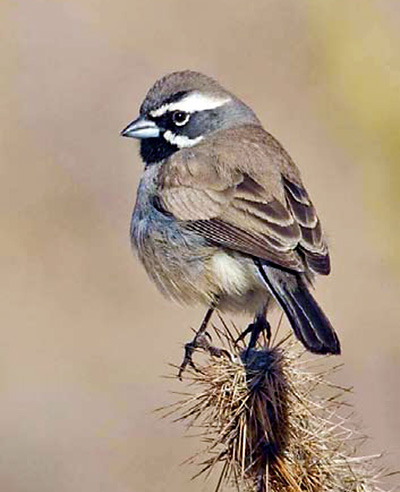
Photo © Alan & Elaine Wilson (wildlifenorthamerica.com)
A number of bird lists have been compiled for the park over the years. The current list contains over 450 species of birds (Flippo 2008). Some common or abundant species that also breed in the park include: the house sparrow (Passer domesticus), pyrrhuloxia (Cardinalis sinuatus), house finch (Carpodacus mexicanus), black-throated sparrow (Amphispiza bilineata), red-tailed hawk (Buteo jamaicensis), scaled quail (Callipepla squamata), white-winged dove (Zenaida asiatica), ladder-backed woodpecker (Picoides scalaris), Say’s phoebe (Sayornis saya), vermillion flycatcher (Pyrocephalus rubinus), Mexican jay, verdin (Auriparus flaviceps), cactus wren (Campylorhynchus brunneicapillus), curve-billed thrasher (Toxostoma curvirostre), and black-tailed gnatcatcher (Polioptila melanura).
Endangered Species
There is one federally listed bird species known to occur at Big Bend NP— the black-capped vireo. This federally listed endangered bird is also considered endangered by the State of Texas. Four other species present at the park, the peregrine falcon (Falco peregrinus), common black-hawk (Buteogallus anthracinus), gray hawk (Asturina nitida), and zone-tailed hawk (Buteo albonotatus), are also listed as endangered or threatened at the state level. Recent studies of the black-capped vireo have been conducted to ascertain its distribution and abundance throughout its breeding range in central Texas, including the park (Groce and Morrison 2009). Within Big Bend NP, these researchers conducted 179 point surveys and obtained location data for 20 black-capped vireos (although some birds may have been counted twice). Also, biologists at the park conduct annual population censuses of the black-capped vireo. From 1987 to 2009, the greatest number of birds detected was 41 (36 males and 5 females) in 2009 (Pomara 2009).
Individual Species Studies
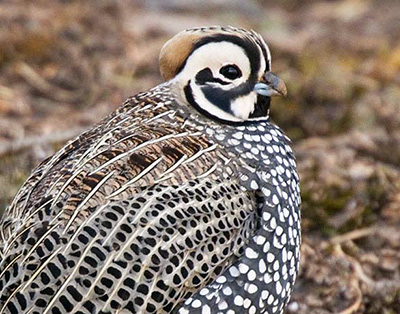
Photo © Robert Shantz
Efforts to learn more about particular species at Big Bend NP include those to document the Montezuma quail (Cyrtonyx montezumae) in the Chisos Mountains in the park. There had been several visitor reports, but no validated records of the species from 1973-2004. In 2004 and 2005, Holderman et al. (2007) documented the bird along the Southwest Rim in mature, open pinyon pine-juniper, or mature, closed oak-pinyon pine-juniper woodlands. Surveys are conducted for another species, the Northern aplomado falcon (Falco femoralis), in the north part of Big Bend NP. This area of the park lies under military training routes where the Air Force surveys for the endangered falcon. No aplomado falcons were observed on the survey routes in the park in 2006 (Border Wildlife Consultants 2006), but one falcon was observed near Dugout Wells in March 2007 and another on the Dodson Trail in November 2008. Surveys have also been conducted for colima warblers to monitor the stability of the population. A 2005 survey (the eleventh one conducted) recorded 75 warbler territories in the Chisos Mountains over a three-day period (Weber and Weber 2005).
Peregrine falcons, on the federal Endangered Species List from 1970-1999 and still listed as threatened at the state level, have been recorded nesting in the Big Bend region since the early 1900s. The high and inaccessible cliffs of the Chisos Mountains and deep canyons of the Rio Grande provide safe haven for falcon eyries and plentiful hunting grounds. NPS staff and contractors, in cooperation with the U.S. Fish and Wildlife Service (USFWS), have monitored falcons every year from 1976-2003, collecting data on the reproductive success of the small population. The population has experienced reproductive failures since 1990 (Siegel 1997, Mora et al. 2007). Concern over the failures led to a study of contaminants in potential prey species, which revealed that persistent, toxic compounds (selenium, mercury, and DDE [a metabolite of DDT]) have accumulated in the food chain along the Rio Grande (Mora et al. 2007). These compounds may be the cause of the reproductive failures and reduced reproductive success. In accordance with USFWS post-delisting criteria, three sample surveys of four eyrie sites have occurred in recent years.
Migratory Birds
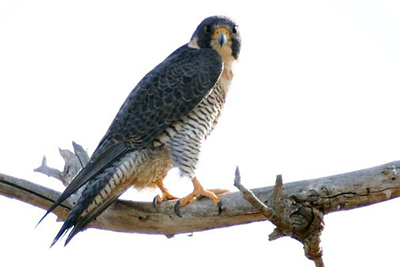
Photo © Robert Shantz
For years, people have come to Big Bend NP in the spring specifically to see the diversity of birds that pass through in the annual migration. About 40% of the birds that have been recorded in the park are migrants in route to their breeding grounds to the north. This includes those known as “neotropical” migrants—those that nest in the U.S. and Canada, and winter south of the U.S. In some years, birds observed during migration are “vagrants,” birds that are off course from their normal range or migration routes. During the spring of 1996, for example, two species listed as “hypothetical” (at that time) on the park list visited the area, a violet-crowned hummingbird (Amazilia violiceps) and a Swainson’s warbler (Limnothlypis swainsonii). Other rare bird sightings in that year included two individual flame-colored tanagers (Piranga bidentata), the first-ever record for Texas. Vagrants observed at the park in other years include the Aztec thrush (Ridgwayia pinicola), black-legged kittiwake (Rissa tridactyla), and Costa’s hummingbird (Calypte costae; Flippo 2008).
A count focusing on migratory birds, the North American Migratory Bird Count, recorded 116 species of birds in the park in May 1995 (Edwards 1995). There were 12 species for which 40 or more individuals were observed, and there were 5 species for which 50 or more individuals were observed. Those recorded in the highest numbers were: brown-headed cowbird (Molothrus ater), Audubon’s warbler (Dendroica coronata auduboni), Wilson’s warbler (Wilsonia pusilla), turkey vulture (Cathartes aura), painted bunting (Passerina ciris), yellow-breasted chat (Icteria virens), blue-gray gnatcatcher (Polioptila caerulea), and hermit thrush (Catharus guttatus). Of these, only the Wilson’s warbler is listed as a migrant on the park’s 2010 bird list (Flippo 2010). Other migrant species recorded include the Virginia’s warbler (Vermivora virginiae), Northern parula warbler (Parula americana), yellow warbler (Dendroica petechia), palm warbler (Dendroica palmarum), and ovenbird (Seiurus aurocapilla).
Wintering Birds
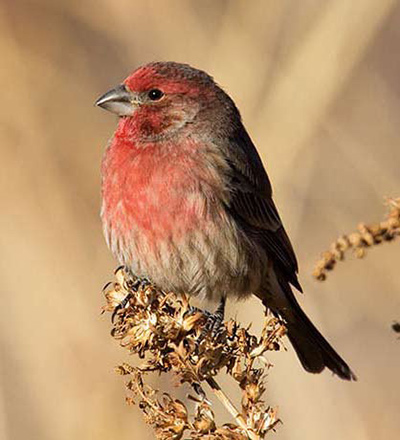
Photo © Robert Shantz
A recent study at the park censused grassland habitats for the presence, diversity, and abundance of wintering birds (Bryan 2005). A total of 2,844 individuals of 73 species were encountered on the 78 total transect runs (in four grassland habitat types). The highest number of species recorded (43) was in the riparian grassland habitat type (at Rio Grande Village). The highest individual count from combined results from a single habitat type was 588 in the lower desert grasslands (at the Burro Mesa transect site). Thirteen species were detected in all four grassland habitat types; these included the greater roadrunner (Geococcyx californianus), Say’s phoebe, loggerhead shrike (Lanius ludovicianus), common raven (Corvus corax), Bewick’s wren (Thryomanes bewickii), and green-tailed towhee (Pipilo chlorurus). The number of species found only within a particular habitat type was: five for tobosa grasslands; 25 for riparian grasslands; zero for lower desert grasslands; and four for Chisos foothills grasslands. The most abundant species overall (all habitats/data combined) were the Western bluebird (Sialia mexicana), dark-eyed junco (Junco hyernalis), rufous-crowned sparrow (Aimophila ruficeps), bushtit (Psaltriparus minimus), house finch, sage sparrow (Amphispiza belli), Towsend’s solitaire (Myadestes townsendi), canyon towhee (Pipilo fuscus), horned lark (Eremophila alpestris), and black-throated sparrow.
Potential climate change impacts on eight bird species were recently examined at Big Bend NP. The project’s approach was to couple two modeling systems—an ecosystem process model to simulate vegetation changes associated with climate change and fire management, and bird-landscape models derived from field observations and landscape statistical analyses (Barrow et al. 2004). The field observations included winter point-count surveys at 70 sites (the same sites established by Gutzwiller and Barrow 2001) in 1999-2001; eight surveys were conducted at each site between December 15 and March 1. Of the eight bird species studied (scaled quail, Say’s phoebe, loggerhead shrike, rock wren, ruby-crowned kinglet [Regulus calendula], black-tailed gnatcatcher, black-throated sparrow, and the white-crowned sparrow [Zonotrichia leucophrys]), three (scaled quail, loggerhead shrike, and rock wren) showed minor to moderate descreases in probability of occurrence. For the most part, the eight birds selected were among those with the highest (or relatively high) number of observations and/or the highest (or relatively high) frequency of occurrence.
Breeding Birds
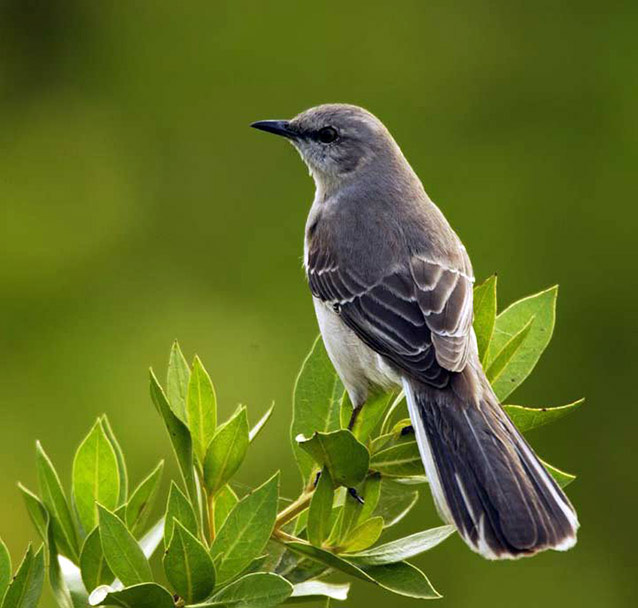
Photo by Ryan Hagarty, USFWS
Birds are monitored along three routes (Hot Springs, Chisos Basin, and Castolon) at Big Bend NP every year as part of the North American Breeding Bird Survey (BBS). The BBS is a long-term, large-scale, international bird monitoring program started in 1966 to track the status and trends of North American bird populations (URL: https://www.pwrc.usgs.gov/bbs). Data are available for the Hot Springs route at Big Bend for 1967-2009 (except for a few non-consecutive years when the route was not counted) and for the Chisos Basin route and Castolon route for 1995-2009 and 1994-2009, respectively. For the years available, an average of 30 species per year and 467 individuals per year have been counted on the Hot Springs route; 41 species per year and 457 individuals per year on the Chisos Basin route; and 36 species per year and 428 individuals on the Castolon route. Species among those recorded in the highest numbers along all three routes include the black-throated sparrow, pyrrhuloxia, cactus wren, Northern mockingbird (Mimus polyglottos), and scaled quail.
Monitoring riparian birds on the west side of the park began in June 2008 as part of a saltcedar (Tamarix spp.) control program (Doster 2009). A biological control agent (the saltcedar leaf beetle [Diorhabda elongata]) is being used to control the non-native saltcedar, and ecosystem variables (such as bird use of habitat) are being monitored to detect changes in habitat due to the control program. Bird survey points are in six general areas in the Rio Grande riparian corridor and at one site along Terlingua Creek. In the first monitoring effort (June 2008), 282 individual birds of 30 species were detected. Those detected in the highest numbers were Bell’s vireo (Vireo bellii), white-winged dove, and yellow-breasted chat.
Birds were also sampled in Big Bend NP from 1995-1997 to assess bird-landscape relationships (Gutzwiller and Barrow 2001, 2002, 2003, 2008). Birds were sampled in 70 sites in late February-late May, which coincided with the breeding season. Researchers conducted one 20-minute unlimited-distance point count at the center of each sampling site each of the twelve weeks. Information was collected to calculate indices such as species richness and relative abundance. One hundred and fifty-seven bird species were detected during the three years, but the majority (67%) of these occurred on fewer than 10% of the sites in most years (Gutzwiller and Barrow 2003). Twenty-six species were detected at 20% or more of the sites each year, making them abundant enough to study quantitatively. These 26 species included the turkey vulture, ash-throated flycatcher (Myiarchus cinerascens), Scott’s oriole (Icterus parisorum), rock wren (Salpinctes obsoletus), black-throated sparrow, and greater roadrunner.
Summary
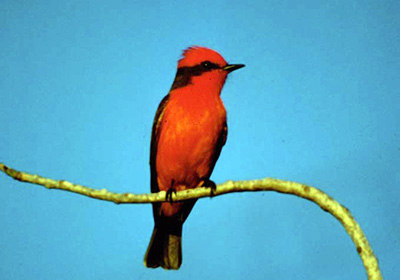
Photo by Rob Bennetts
Description and results of a number of surveys and studies of Big Bend NP’s more than 450 bird species have been discussed here. A number of other bird surveys/studies have been or are being conducted at the park. Additional information can be obtained on the park (URL: https://www.nps.gov/bibe/naturescience/birds.htm) and Science of the American Southwest (URL: https://www.nps.gov/swscience) websites. Also, landbird monitoring will be conducted annually at Big Bend NP starting in 2010. As part of the CHDN Inventory & Monitoring Program, birds will be monitored during the breeding season, when detection rates and sampling efficiencies are high and more bird species are present. Data will be used to estimate occupancy, species richness and composition, and density (when feasible).
Literature Cited
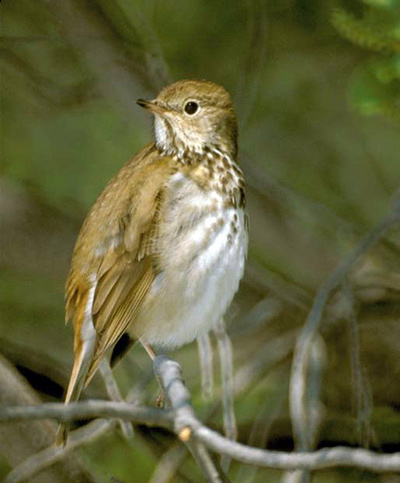
Photo by Rob Bennetts
Barrow, W. C., Jr., K. J. Gutzwiller, J. D. White, and L. J. Randall. Interactive effects of climate change and fire on bird communities: Landscape and Regional Projection. Final Report on the Ecosystem Process Modeling and Bird Projections for the Big Bend National Park Region.
Border Wildlife Consultants. 2006. Aplomado falcon surveys conducted in Big Bend National Park, Texas, 2006. Submitted to Big Bend National Park.
Bryan, K. 2005. A survey of winter-resident grassland birds in Big Bend and Guadalupe Mountains National Parks.
Doster. R. H. 2009. Riparian bird monitoring at saltcedar biocontrol control sites-Big Bend National Park, Texas. U.S. Department of the Interior, Bureau of Reclamation.
Edwards C. 1995. Fourth Annual North American Migratory Bird Count. May 13, 1995. Report to Big Bend National Park.
Flippo, M. 2008. Bird checklist: Big Bend National Park, Rio Grande Wild and Scenic River, Texas. Big Bend Natural History Association, Big Bend National Park, Texas.
Groce, J. and M. L. Morrison. 2009. Determining the baseline status of black-capped vireos in Texas. Report of surveys conducted by Texas A&M University on Big Bend National Park.
Gutzwiller, K. J. and W. C. Barrow, Jr. 2001. Bird-landscape relations in the Chihuahuan Desert: Coping with uncertainties about predictive models. Ecological Applications 11(5):1517-1532.
Gutzwiller, K. J. and W. C. Barrow, Jr. 2002. Does bird community structure vary with landscape patchiness? A Chihuhuan Desert perspective. Oikos 98:284-298.
Gutzwiller, K. J. and W. C. Barrow, Jr. 2003. Influences of roads and development on bird communities in protected Chihuhuan Desert landscapes. Biological Conservation 113:225-237.
Gutzwiller, K. J. and W. C. Barrow, Jr. 2008. Desert bird associations with broad-scale boundary length: Applications in avian conservation. Journal of Applied Ecology 45:873-882. doi10.1111/j.1365-2664.2007.01450.x.
Holdermann, D. A., S. Sorola, Jr., and R. Skiles. 2007. Recent photo- and audio-documentation of Montezuma quail from the Chisos Mountains, Big Bend National Park (BBNP), Texas. Bull. Texas Ornithological Society 40(2).
Mora, M. A., R. S. Skiles, and M. Paredes. 2007. Further assessment of environmental contaminants in avian prey of the peregrine falcon in Big Bend National Park, Texas. Southwestern Naturalist 52(1):54-59.
Pomara, L. 2009. Annual Big Bend NP black-capped vireo survey. Unpublished report to the National Park Service.
Siegel, E. 1997. Status report: Peregrine falcons in Big Bend National Park and the Rio Grande Wild and Scenic River 1997. National Park Service, Big Bend National Park, Texas.
Weber, J. and L. Weber. 2005. Colima warbler census, 2005 report. Report to Big Bend National Park.
Prepared by Patty Valentine-Darby, Chihuahuan Desert Network Inventory & Monitoring Program, 2010.
Last updated: October 1, 2018
